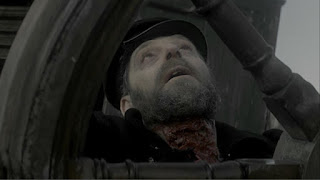I commented on social media last week that I thought you could stage The Last Voyage of the Demeter (2023, directed by André Øvredal) as a play. Find a production of The Pirates of Penzance that's closing and mooch on their sets and you're all ready to go. One of my friends asked if I would make it a musical. I absolutely would. It would be the off-off-Broadway hit of the season. Buy your tickets now.
The story of the Demeter is from Dracula, of course. It occupies chapter seven of Stoker's novel, represented as news clippings pasted into Mina Murray's journal and as the logbook of the ship as reported in those clippings. The Demeter is usually seen at the end of its journey in movies. In the Tod Browning film, the sole survivor is Renfield (he is not on the ship in the book), with Dwight Frye's mad grin staring up at the investigators when the Demeter drifts into harbor. In Murnau's film version, there's an abbreviated version of the voyage. The first still from Nosferatu I ever saw was of Max Schreck standing on the deck of the Demeter. This was years before I ever saw the film. The most indelible version of the Demeter I ever saw was in John Badham's 1979 version of Dracula in which Harker joins the rescuers for the wrecked ship only to discover a man lashed to the wheel with his throat ripped open. A version of this image appears in Jon J. Muth's graphic novel, Dracula, A Symphony In Moonlight and Nightmares. The final voyage of the Demeter from Varna, Bulgaria, to Whitby, United Kingdom is such a vivid part of the Dracula story that it's shocking that no-one has made a film of its voyage until now. It's been, what? A hundred and twenty-six years at this point?
A lot of the imagery from previous versions makes it into this new film, but most of that imagery was already there in Stoker's book. It's a rich novel for interpolations.

















